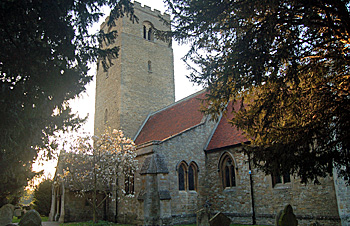Early Education in Clapham

The church from the south-east April 2010
Volume 81 published by Bedfordshire Historical Records Society (2002) is a series of episcopal visitations undertaken in the first twenty years of the 18th century, edited by former County Archivist Patricia Bell. At each visitation a list of questions was sent out in advance, one of which enquired about the provision of schools in each parish. In 1706 the curate declared: “There is no lecture, School Almeshouse, or Hospital, endowed, within this parish”. Similarly in 1717 he reported that there was no school.
Bedfordshire Archive and Record Service has a copies, courtesy of a former headmaster, of a number of documents concerning the school [CRT130Clapham7]. One of these is an extract of the will of Ursula Taylor of 3rd September 1722, proved in 1724: “And the Twenty four pounds a year I purchased of Matthew Woolhead lying in the parish of Marston in the County of Bedford I leave for ever to the Poor of Clapham in the said County, to put out apprentice to some Trade every Year One or Two poor Children, that their Parents are so poor and low in the Woald they are not able to make any Provision for them . And I doe hereby nominate and appoint for Trustees of this my Gift to the Town of Clapham, that is to the Poor thereof, the Minister of Saint Paul’s in Bedford and the Minister of Saint John’s in the said Town of Bedford and their successors in those Livings for ever to receive the Rents of the aforesaid estate and to have management of it, desiring them and their successors once a year to choose out and bind apprentice a Child or Children that are the greatest Objects of Charity”. The lands amounted to 60 acres, 1 rood, 4 poles in Marston Moretaine and 3 acres, 1 rood, 5 poles in Wootton. This charity was, in the 20th century, applied to the school instead of to apprenticeships.
In 1818 a Select Committee was established to enquire into educational provision for the poor. This was no doubt prompted, in part, by the recent foundation of two societies promoting education and specifically the building of schools. The Society for Promoting the Lancasterian System for the Education of the Poor was established in 1808 promoting schools run along the lines pioneered by Joseph Lancaster, who had himself copied those of Dr. Andrew Bell, in which older children taught their younger fellows. The Society was renamed the British and Foreign School Society in 1814. It was supported by a number of prominent nonconformists, Lancaster himself was a Quaker, and sought to teach a non-sectarian curriculum. In answer to this perceived nonconformist takeover of local education the National Society was formed in 1811 to encourage the teaching of poor children along Anglican lines, including the catechism. The Select Committee sent a questionnaire to all parishes in the country asking for: particulars relating to endowments for the education of children; other educational institutions; observations of parish needs etc. The vicar reported that there was no school but there was a Sunday school “supported by subscription”. In those days a Sunday School was just that, a school which met on a Sunday, usually in the church or nonconformist chapel or other similar building, teaching more than the religious topics with which they are associated today. The vicar added: “The poor are desirous for their children to be educated”.
In the country generally the number of schools built continued to grow over the next fifteen years so that by 1833 the government agreed to supplement the work of the two societies, and local benefactors, by making £20,000 per annum available in grants to help build schools. It also prompted another questionnaire to be sent to each parish in England asking for details of local educational provision. Clapham still just had a Sunday school, supported by voluntary contributions. This was attended by 45 children of both sexes.
The next national enquiry was in 1846/7 when the Church of England made an enquiry as to all its church schools. This was against the background of a new Whig government which championed secular education and the increasing importance of nonconformists, particularly Wesleyan Methodist, and Roman Catholics in providing schools. The return for Clapham noted that the Sunday school had forty boys and thirty girls: “There is no Daily school in this parish, but measures are being taken for establishing a good one shortly”.
The entry for Clapham in The Post Office Directory for 1854 indicated existence of that school: “Here is also a free school for children of both sexes, supported by the Rev James Donne, BD, and Tev John Frederick Dawson”. Donne was the vicar and Dawson lived at Woodlands. This school was still in operation in 1869 and was supplanted by a new public elementary school in 1872.